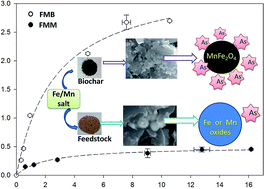Sorption of arsenate onto magnetic iron–manganese (Fe–Mn) biochar composites†
Abstract
Bimetal adsorbents attract much attention because of their good sorption ability to arsenate (As(V)). In this work, biochar-supported bimetal adsorbents were prepared through either direct pyrolysis of Fe and Mn ion treated pinewood biomass (FMM) or co-precipitation of Fe and Mn ions onto pinewood biochar (FMB). The two Fe–Mn biochar composites were characterized using X-ray diffraction (XRD), X-ray photoelectron spectroscopy (XPS), scanning electron microscopy (SEM), and energy-dispersive X-ray (EDS) analyses. Characterization results suggest that maghemite (γ-Fe2O3) and manganosite (MnO) are the dominant metal crystals in FMM, while manganese ferrite (MnFe2O4) is the dominant bimetal crystal in FMB. Batch sorption experiments showed that the maximal As(V) sorption of FMB and FMM was 3.44 and 0.50 g kg−1 respectively, which are higher than that of the unmodified biochar. As(V) sorption by FMM and FMB decreased with increasing solution pH (between 3–9). Results of this work suggest that co-precipitation is more effective in preparing magnetic Fe–Mn biochar composites for As(V) removal.


 Please wait while we load your content...
Please wait while we load your content...